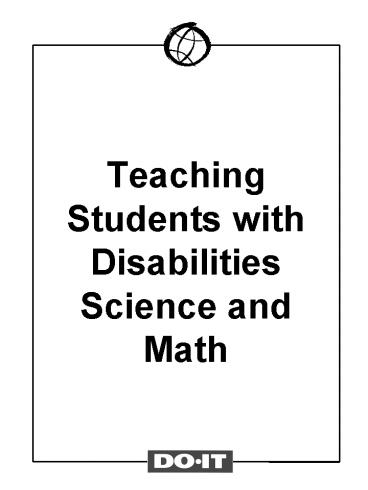Teaching Students with Disabilities Science and Math - PowerPoint PPT Presentation
1 / 80
Title: Teaching Students with Disabilities Science and Math
1
- Teaching Students with Disabilities Science and
Math
2
(No Transcript)
3
(No Transcript)
4
5
Accommodation Strategies
6
? survival rate ? technology ? K-12
special education ? awareness
Factors Influencing the Increased Participation
of Students with Disabilities in Postsecondary
Education
7
Accommodation Strategies Objectives
? Learn about the rights, responsibilities,
contributions, and needs of students with
disabilities. ? Summarize campus and
departmental rights and responsibilities for
ensuring equal opportunities. ? List strategies
for working with students who have
disabilities. ? Describe actions that we can
take to ensure that students with disabilities
have education opportunities equal to those of
their nondisabled peers. ? Describe resources.
8
A person with a disabilityis any person who
- has a physical or mental impairment which
substantially limits one or more major life
activities including walking, seeing, hearing,
speaking, breathing, learning, and working - has a record of such an impairment or
- is regarded as having such an impairment.
9
Examples of DisabilitiesLow VisionBlindnessH
earing ImpairmentsMobility ImpairmentsPsychiat
ric ImpairmentsHealth ImpairmentsLearning
Disabilities
10
Accommodations for Low Vision
- Seating near front of class good lighting
- Large-print ?books, handouts, signs, equipment
labels - TV monitor connected to microscope to enlarge
images - Assignments in electronic format
- Software to enlarge screen images
- Software to adjust screen colors
11
(No Transcript)
12
(No Transcript)
13
(No Transcript)
14
Accommodations forHearing Impairments
Interpreter, real-time captioning FM
System Note Taker Captioned videos
Electronic mail Visual aids visual warni
ng system for lab emergencies
Written assignments, lab instructions,
demonstration summaries Repeating questio
ns statements from other students during class
15
Accommodations for Mobility Impairments
Note taker/lab assistant Group lab
assignments Classrooms, labs, field trips in
accessible locations Adjustable
table Equipment located within reach Extra
exam time, alternative testing
arrangements Access to online research reso
urces Class assignments materials in
electronic format Computer with special
input device (e.g., speech input, large
keyboard)
16
(No Transcript)
17
Accommodations for Speech Impairments Listen
carefully to what the person is saying if you
dont understand, ask her to repeat. Relax an
d take as much time as necessary to
communicate. Ask questions that require
short answers or a nod of the head when
appropriate. Use written communication. Use
email.
18
Accommodations for Psychiatric Impairments Tape
recorder, note taker Preferential seating
near door Tests, assignments in alternate
formats Extended time for taking
tests Separate, quiet room for testing
Reviewing academic and behavioral
expectations in regular meetings with student
19
General Suggestions for Making Classes
Accessible Add a statement to the syllabus
inviting students who have disabilities to disc
uss accommodation needs. Select materials
early. Talk with student about accommodation
needs. Have policies and procedures in
place. Make sure facility is accessible. Prov
ide materials in electronic formats. Provide
clear signage in large print. Use alternative
methods of administering tests and testing
comprehension of a subject. Use campus
disabled student services as a resource.
20
21
Four-Step Model 1. What does the task/assignment
require? 2. What physical, sensory, and
cognitive skills are needed? 3. What components
of the task require accommodation? 4. What
accommodation options exist?
22
(No Transcript)
23
(No Transcript)
24
Universal Design of Instruction
25
(No Transcript)
26
Diversity Ethnic/racial minorities
English as a second language Different
learning styles People with disabilities
27
Universal Design The design of products and
environments to be usable by all people, without
the need for adaptation or specialized design.
Center for Universal Design,
North Carolina State University
28
Principles of Universal Design Equitable use
Flexibility in use Simple and intuitive
use Perceptible information Tolerance for
error Low physical effort Size and shape
for approach use
29
Universal Design of Instruction 1. Class
Climate. Adopt practices that reflect high values
with respect to both diversity and inclusiveness.
2. Physical Access, Usability, and
Safety. Assure that activities, materials, and
equipment are physically accessible to and usable
by all students that all potential student char
acteristics are addressed in safety consideration
s. 3. Delivery Methods. Use multiple
accessible instructional methods. 4.
Information Resources. Assure that course
materials, notes, other information resources a
re flexible accessible to all students.
30
Universal Design of Instruction 5.
Interaction. Encourage effective interactions
between students and between students the
instructor and assure that communication methods
are accessible to all participants. 6.
Feedback. Provide specific feedback on a regular
basis. 7. Assessment. Regularly assess student
progress using multiple, accessible methods
tools and adjust instruction accordingly. 8.
Accommodation. Plan for accommodations for
students for whom the instructional design does
not meet their needs.
31
(No Transcript)
32
(No Transcript)
33
(No Transcript)
34
(No Transcript)
35
(No Transcript)
36
(No Transcript)
37
(No Transcript)
38
(No Transcript)
39
(No Transcript)
40
(No Transcript)
41
(No Transcript)
42
(No Transcript)
43
(No Transcript)
44
(No Transcript)
45
(No Transcript)
46
(No Transcript)
47
(No Transcript)
48
(No Transcript)
49
(No Transcript)
50
(No Transcript)
51
(No Transcript)
52
(No Transcript)
53
(No Transcript)
54
(No Transcript)
55
(No Transcript)
56
(No Transcript)
57
(No Transcript)
58
(No Transcript)
59
(No Transcript)
60
(No Transcript)
61
(No Transcript)
62
(No Transcript)
63
(No Transcript)
64
(No Transcript)
65
(No Transcript)
66
(No Transcript)
67
(No Transcript)
68
(No Transcript)
69
(No Transcript)
70
(No Transcript)
71
(No Transcript)
72
(No Transcript)
73
(No Transcript)
74
(No Transcript)
75
(No Transcript)
76
(No Transcript)
77
(No Transcript)
78
(No Transcript)
79
(No Transcript)
80
(No Transcript)































